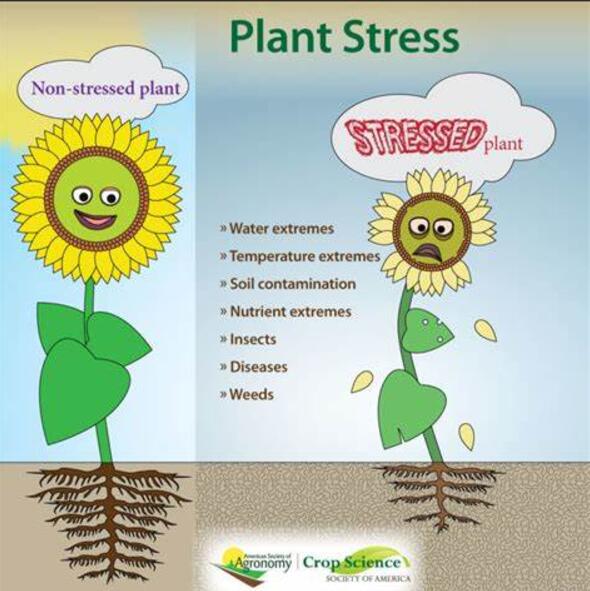Trichoderma Combined with 1-Aminocyclopropane-1-carboxylic acid (ACC) Soil Amendments Modulates the Root Microbiome and Improves Wheat Growth Under Salinity Stress
IF 6.8
Q1 PLANT SCIENCES
引用次数: 0
Abstract
Salinity stress in agricultural soils impairs plant defense responses and imposes multiple effects, including ionic imbalance, osmotic and oxidative stress. Consequently, devising and customizing more effective solutions for mitigating salinity stress in crops are vital. The microbial enzyme 1-aminocyclopropane-1-carboxylic acid (ACC) deaminase, which cleaves the ethylene precursor, ACC, is presumed to decrease stress-induced senescence and promote plant growth. In this study, halotolerant Trichoderma viride Th4 was isolated from salt cedar (Tamarix chinensis Lour.) rhizosphere soils and mass-cultured for use as a seed inoculant. ACC soil amendment is thought to promote the proliferation of root-associated microorganisms with ACC deaminase activity. A glasshouse experiment was conducted to determine the effects of T. viride Th4 and ACC, when applied individually or in combination, on the root microbiome communities and physio-biochemical attributes of wheat plants grown in pots containing nonsaline or saline soil. Control (CK) and stress-CK reference pots were also prepared. The highest fungal richness was observed in the roots of plants treated with T. viride Th4, in both nonsaline and saline soils, whereas the highest fungal diversity was observed in the T. viride Th4, ACC, and their coapplication treatments in saline soil. Moreover, ACC soil amendment consistently increased bacterial richness and diversity in the root endosphere, whereas T. viride Th4, ACC, and their coapplication decreased the richness and diversity of the rhizosphere microbiome in saline soil. Individual ACC soil amendment or coapplication with T. viride Th4 increased the abundance of the genus Rhodanobacter and reduced that of the genus Ochrobactrum in the root endosphere of the stressed plants. Saline soil significantly increased sodium (Na+) accumulation in wheat roots and shoots. However, T. viride Th4, ACC, and their coapplication reduced the Na+ content in the roots by 21.5%, 27%, and 9.5%, respectively, and in the shoots by 31.7%, 9.9%, and 23.44%, respectively, compared with the stress CK treatment. Salinity stress also decreased the leaf chlorophyll a content, but T. viride Th4 application or coapplication with ACC increased it by approximately 6.6% and 11.3%, respectively. Furthermore, salinized wheat treated with T. viride Th4 alone or in combination with ACC presented increased activities of superoxide dismutase (SOD; 27.23% and 14.23%, respectively), catalase (CAT; 161.85% and 151.28%, respectively), ascorbate peroxidase (APX; 64.15% and 128.74%, respectively), and guaiacol peroxidase (GPX; 57.61% and 12.38%, respectively) compared with those in the stress CK treatment. Compared with the stress CK treatment, the ACC treatment slightly reduced SOD activity (5.29%) but increased CAT (78.86% and GPX (58.57%) activity. The findings of the present study suggest that T. viride Th4 application alone or in combination with ACC results in increased antioxidant activity and counteracts detrimental effects, thus improving wheat growth. Additionally, our results provide insights into a promising way to leverage plant-beneficial soil microbes to reinforce salinity tolerance in wheat tissues, although the multifaceted synergies between Trichoderma and ACC and their broad-scale applications need to be more fully elucidated.
求助全文
约1分钟内获得全文
求助全文
来源期刊

Plant Stress
PLANT SCIENCES-
CiteScore
5.20
自引率
8.00%
发文量
76
审稿时长
63 days
期刊介绍:
The journal Plant Stress deals with plant (or other photoautotrophs, such as algae, cyanobacteria and lichens) responses to abiotic and biotic stress factors that can result in limited growth and productivity. Such responses can be analyzed and described at a physiological, biochemical and molecular level. Experimental approaches/technologies aiming to improve growth and productivity with a potential for downstream validation under stress conditions will also be considered. Both fundamental and applied research manuscripts are welcome, provided that clear mechanistic hypotheses are made and descriptive approaches are avoided. In addition, high-quality review articles will also be considered, provided they follow a critical approach and stimulate thought for future research avenues.
Plant Stress welcomes high-quality manuscripts related (but not limited) to interactions between plants and:
Lack of water (drought) and excess (flooding),
Salinity stress,
Elevated temperature and/or low temperature (chilling and freezing),
Hypoxia and/or anoxia,
Mineral nutrient excess and/or deficiency,
Heavy metals and/or metalloids,
Plant priming (chemical, biological, physiological, nanomaterial, biostimulant) approaches for improved stress protection,
Viral, phytoplasma, bacterial and fungal plant-pathogen interactions.
The journal welcomes basic and applied research articles, as well as review articles and short communications. All submitted manuscripts will be subject to a thorough peer-reviewing process.
 求助内容:
求助内容: 应助结果提醒方式:
应助结果提醒方式:


